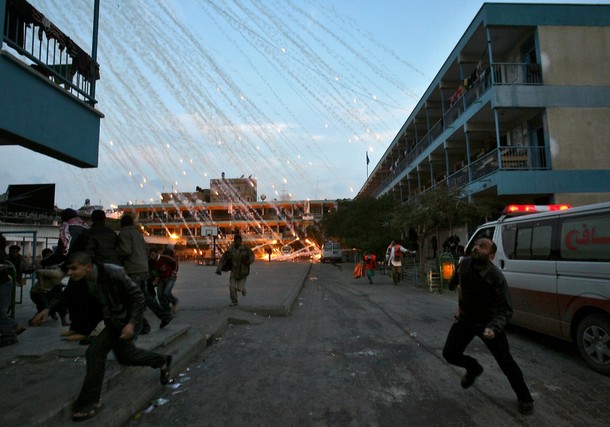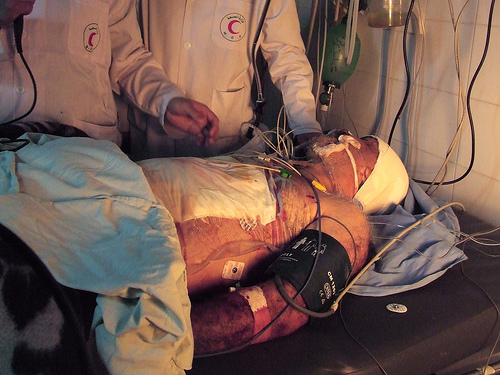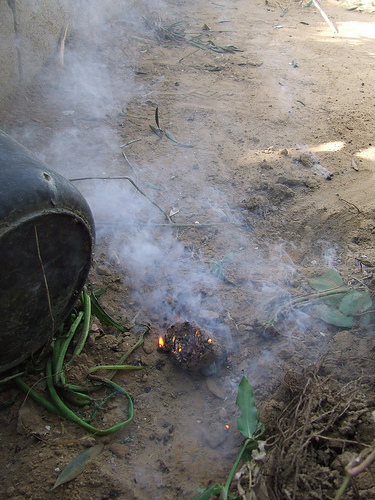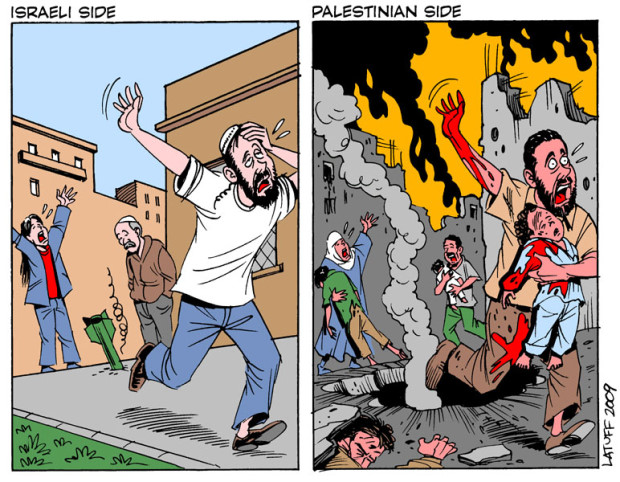From the Guardian, another Israeli war crime:
In testimony collected from residents of the village of Khuza’a by the Observer, it is claimed that Israeli soldiers entering the village:
• attempted to bulldoze houses with civilians inside;
• killed civilians trying to escape under the protection of white flags;
• opened fire on an ambulance attempting to reach the wounded;
• used indiscriminate force in a civilian area and fired white phosphorus shells.
If the allegations are upheld, all the incidents would constitute breaches of the Geneva conventions.
Previous war crimes are hotly denied by the hasbara machine:
The Israeli army announced yesterday that it was investigating “at the highest level” five other attacks against civilians in Gaza, involving two UN facilities and a hospital. It added that in all cases initial investigations suggested soldiers were responding to fire. “These claims of war crimes are not supported by the slightest piece of evidence,” said Yigal Palmor, an Israeli foreign ministry spokesman.

More evidence of white phosphorus illegally used on civilians:

January 16, 2009
Missiles believed to contain white phosphor were deployed by the Israeli military during this attack. International volunteers photographed a fist-sized lump of flaming material found on the ground next to a burnt-out home. It was still burning from the previous day.
The only way to extinguish it was to bury it, but it would instantly re-ignite if uncovered. It was giving off a thick grey smoke with a foul stench. Doctors at the Al Nasser Hospital in Khan Younis, which received 50 casualties that day from Khoza’a, described serious chemical burns and victims being covered in a white powder which continued to burn them. Many people were also suffering from serious breathing difficulties after inhaling smoke emitted by this weapon.
Dr. Ahmed Almi, a member of the delegation of Egyptian doctors who finally gained entry to the strip to support Gazan hospitals during the crisis, outlined some of the most serious cases. Four of them died in the hospital after doctors battled to save them. He commented that some of the injuries were so horrific they must have been inflicted by abnormal munitions. He gave the example of a man who had been shot and sustained a small entry wound but massive exit wound, 40-50 cm wide. 13 people were killed overall during this incursion according to medical sources.
Before the Israeli war on Gaza began, volunteers here had been working with the farming community in Khoza’a, accompanying local farmers as they succeeded to access their land to plant winter wheat. The IOF had prevented them from reaching their fields, in some cases for over five years. Israeli soldiers shot at them, even during the ceasefire. The same ceasefire which Israel claims was broken by Palestinians. . – Photo & text courtesy of Rafahkid
Pictures taken by photographer Bruno Stevens in the aftermath show heavy damage – and still burning phosphorus. “What I can tell you is that many, many houses were shelled and that they used white phosphorus,” said Stevens yesterday, one of the first western journalists to get into Gaza. “It appears to have been indiscriminate.” Stevens added that homes near the village that had not been hit by shell fire had been set on fire.
The village of Khuza’a is around 500 metres from the border with Israel. According to B’Tselem, its field researcher in Gaza was contacted last Tuesday by resident Munir Shafik al-Najar, who said that Israeli bulldozers had begun destroying homes at 2.30am.
The stuff of nightmares – terror incarnate:
Marwan Abu Raeda, 40, a paramedic working for the Nasser hospital in Khan Younis, said: “At 8am we received a phone call from Khuza’a. They told us about the injured woman. I went immediately. I was 60 or 70 metres away from the injured woman when the Israeli forces started to shoot at me.” As he drove into another street, he came under fire again. Twelve hours later, when Rawhiya was finally reached, she was dead.
Iman said she ended up in an area of rubble where a large group of people had sought cover in a deep hole among the debris of demolished houses. It is then, she says, that bulldozers began to push the rubble from each side. “They wanted to bury us alive,” she said.
There’s also evidence of other new weaponry being tested against Gazans including the GPS-guided mortar, GBU-39 [aka DIME] and the Spike, a weapons jointly developed by the U.S. Navy with Rafael, the Israel Armament Development Authority.

7th January 2009
Update for Wednesday 14th January, 2009
In an escalation of the ground offensive in the south of the Gaza Strip, Israeli forces terrorised the population of Khoza’a, a small rural community east of Khan Younis. They entered the area at about 3.00am on the morning of Tuesday 13th January in an incursion lasting until Tuesday evening. This follows heavy missile strikes on Khoza’a in recent days, notably on Saturday 10th January.
According to a local municipality official, approximately 50 homes were bulldozed along with farmland, olive and citrus groves. The scent of lemons could faintly be determined whilst navigating the wreckage, emanating from so many mangled trees. A family explained how their home was demolished with them inside it. They sheltered in the basement as the upper storeys were destroyed. Later they realised the basement itself was being attacked and narrowly missed being crushed to death by escaping through a small hole in the debris.
Iman Al-Najar was with her family in their home when military D-9 bulldozers began to demolish it. They managed to escape and Iman then encouraged some of her neighbours to try to leave the vicinity. The group of women were instructed by Israeli soldiers to leave by a particular street. They had children with them and carried white flags, yet when they reached the street Israeli special forces concealed in a building opened fire on them and shot 50 year-old Rowhiya Al-Najar. The other women desperately tried to rescue her but the gunfire was too heavy and they had to flee for their lives. An ambulance was also prevented from reaching her and she bled to death in the street.
Meanwhile Iman and about 200 other residents whose homes had been destroyed had gathered near her uncle’s house which was protecting them to some degree from the shooting. However, this area in turn was also attacked. Iman described how the bulldozers began piling debris up around them, effectively creating a giant hole that they were standing in. They were literally about to be buried alive. By some miracle they managed to also escape from this situation by crawling on their hands and knees for about 150 metres. It was extremely difficult for them to move, especially with the injured and the elderly.
The terrified residents then sought sanctuary at a local UNRWA school. But when they got there missiles were being fired around it and they had to retreat. Finally they managed to leave the area entirely and walked several kilometres to where friends were able to pick them up. Iman’s 14 year-old brother Mohammed was missing for 12 hours and she feared he was dead. He had been detained by soldiers in a house along with a neighbour who had begged to be let out to find her children but was not allowed to do so. When the soldiers had shot Rowhiya Al-Najar, Mohammed said they had been singing and dancing and forced him to do the same. When he refused, they threatened to shoot him too.
“It was the hardest day of our lives,” repeated Iman over and over again. She had nothing left in the world but the clothes she was standing up in, but under the circumstances she was lucky to escape with her life. As in so many other parts of the Gaza Strip, the atrocities committed against civilians in Khoza’a amount to war crimes. – Photo & text courtesy of Rafahkid
While Israeli shill, Mark Regev bleats shallow, pernicious hasbara about Hamas being responsible for child deaths, ruling out any negotations with Hamas, Rabanovich attempts to pass off the carnage in Gaza as a defeat of Iran (Sunnis and Shias must be getting on better these days) and a flock of other hasbaraniks whine about Hamas using human shields, a vacuous canard given the population density in Gaza, Paul Canning points out:
It’s worth noting the following: the Israeli Supreme Court has ruled against the use of Human Shields by the Israeli Defence Force (IDF) in 2005. This ruling was appealed.
And it’s still happening: Israel Uses Gazans as Human Shields.
Hamas has decided to offer its own unilateral truce – for a week.
The group said the ceasefire would be temporary unless Israel also stopped military action, ended its blockade of the Gaza Strip and opened border crossings between Gaza and Israel.
Other armed Palestinian factions have concurred.
“During this period, the resistance is ready to respond to all efforts by the Egyptians, Turks, Syrians and Arabs that will allow for a total withdrawal of Israeli soldiers and the total opening of border crossings.”
Israel has indicated it will maintain a military presence until there are no rockets fired from Gaza, meaning troops could be a fixture at Israel’s leisure.
Doctors are concerned about injuries in the wounded which have not been seen before.
Dr Fosse said he had seen a number of patients with extensive injuries to their lower bodies. “It was as if they had stepped on a mine, but there was no shrapnel in the wounds,” he said. “Some had lost their legs. It looked as though they had been sliced off. I have been to war zones for 30 years, but I have never seen such injuries before.” However, the injuries matched photographs and descriptions in medical literature of the effects of Dime bombs.
….
While the loudest controversy has been over accusations that white phosphorus was illegally used, other foreign doctors working in Gaza have reported injuries they cannot explain. Professor Mohammed Sayed Khalifa, a cardiac consultant from Sudan, said that two of his patients had had uncontrollable bleeding. “One had a chest operation, and continued bleeding even after having been given large quantities of plasma,” he said. “The other had what seemed to be a minor leg injury, but collapsed with profuse bleeding. Something was interfering with the clotting process. I have never seen such a thing before.”
Dr Ahmed Almi, an Egyptian cardio-thoracic consultant at al-Nasser hospital in Khan Younis in southern Gaza, said he had seen a number of patients with inexplicable injuries. A boy of 14 had a small puncture wound in his head, but extensive damage to his brain, making it impossible to save his life. “I don’t know the nature or type of these weapons that make a very small [entry wound] and go on and make massive destruction in the tissues,” he said.
Israeli military representatives have refused to confirm or deny using specific weapons, but insist that all Israel’s weapons comply with international law. Neither white phosphorus nor Dime bombs are illegal, but campaigners say the way they have been used, especially in Gaza’s densely packed urban areas, could constitute a war crime.
Maxwell Gaylard, former Australian diplomat and UN representative issues a helpful description, rejected naturally by the Israelis, of the treachery of Israel under last year’s truce.
“The Israelis would not let us facilitate a regular and sufficient flow of supplies into the strip,” Mr Gaylard, the most senior representative of the UN office that deals with the peace process, told The Age.
…
When Israel launched its surprise attack on Gaza, Mr Gaylard said the UN’s massive warehouses there were nearly empty, with all food and equipment sitting in nearby port facilities.
“The food was in Israel, but we couldn’t get it in,” Mr Gaylard said. “This is before. The blockade was very tight.”
The Age appears to have a case of hasbara plague as it states:
According to Hamas, in return for stopping the rocket fire Israel had promised to ease its blockade of Gaza and allow the passage of more food and commercial supplies.
Had the journalist done his homework, he would have known the terms of the truce specifically stated Israel *would* remove its disgraceful blockade constituting collective punishment of 1.5 million Gazan residents, if the rockets stopped. During the final three months of the truce there were barely any rockets fired, so one can understand Hamas’ unwillingness to back down at this juncture.
Hamas of course was not to know of Israel’s determination to prosecute a carefully timed massacre regardless, in a fiendish plan formulated prior to the commencement of the truce.
Israeli leaders disliked the ceasefire from the start, and Defense Minister Ehud Barak instructed the IDF to begin preparing for the present war while the ceasefire was being negotiated in June 2008. Furthermore, Dan Gillerman, Israel’s former ambassador to the UN, reports that Jerusalem began to prepare the propaganda campaign to sell the present war months before the conflict began. For its part, Hamas drastically reduced the number of missile attacks during the first five months of the ceasefire. A total of two rockets were fired into Israel during September and October, none by Hamas.
“The expectation on the Gazan side … was that more supplies would be allowed in, and it didn’t happen,” Mr Gaylard said.
“In fact, we noticed, I think from June 19 for the next four or five months, or up to even December 19, less of our supplies and spare parts and items of equipment, less got in than before June 19.”
Mr Gaylard slammed Israel’s siege policy towards Gaza, saying it had strengthened Hamas.
“It’s difficult to understand the mentality of firing these rockets … it is equally hard to understand why the Israelis are strangling this place.
“It is to cause Hamas to fall, but my experience of the last year of going in and out of Gaza and staying there was that it had exactly the opposite effect.”
Gaylard also criticises the Israelis’ disingenuous accusation of Hamas using civilians as human shields:
“Everyone is packed in there. So if you attack militants or installations in that area, you are going to cause collateral damage.
“One of the fundamental points about the strip … is that it’s probably the only place in the world that I can think of where you cannot as a civilian flee the conflict.”
Significantly, Gaylard highlights realities on the ground – that a two state solution is becoming less popular as a ‘solution’ to conflict. We agree with his assessment – a pluralistic democracy with mixed ethnicity and equal rights for all would increase societal health and decrease regional animosity.
As for the long-term goal of resolving the Israeli-Palestinian conflict, Mr Gaylard said that while the international community remained in favour of a two-state solution to the conflict, a growing number of Palestinians now preferred the idea of one democratic state including the land’s Jews and Arabs.
He urged the international community to put more pressure on Israel to stop the growth of Jewish settlements in the occupied West Bank, which he said Israel had pledged to do several times, most recently at the Annapolis Middle East peace conference in 2007.
“Palestinians are trying to meet their part of it … security has improved in these key West Bank towns. Meanwhile, (in) the settlements, I don’t see any change,” Mr Gaylard said.
The Israelis are unlikely to move on settlements or other issues before testing their considerable malign influence on the incoming US executive.
Mr Palmor said it was unhelpful to single out the problem of settlements.
“We are trying to conclude a global solution to the conflict, one that will resolve all the issues, including security, refugees, land and settlements.”
Global solution sounds ominous – what on earth is he talking about?
The Boycott Israeli Apartheid movement is kicking off, with Hertz insisting on withdrawal of offers of free car hire in conjunction with El Al flights. Additionally –
Several companies who do business with Israel are facing boycotts. “Emails are being circulated alerting people about which companies to boycott,” said Inayat Bunglawala, from the British Muslim organisation ENGAGE.
In South Africa, MPs cornered the Israeli ambassador with
a severe tongue-lashing, accusing his government of perpetrating “racist” abuses against the Palestinian people “that make apartheid look like a Sunday school picnic”.
And as the war in Gaza rages for its fourth week, Cosatu has called for the Israeli ambassador to be “kicked out” of South Africa, for the embassy to be “shut down,” for a “total boycott of Israeli goods” and for the “savage rule of Zionism over the Palestinian territories to come to and end”.
A red-faced and clearly agitated Segev-Steinberg dismissed apartheid comparisons as “rubbish,” but the National Assembly’s foreign affairs committee chairperson, Job Sithole, was unrelenting in his condemnation of the Israeli government and its armed forces.
“When Palestinians have to go through checkpoints like cattle through a dip, this is apartheid. When they cannot drive on the roads by virtue of the fact that they are Palestinian, this is apartheid,” the chairperson insisted.
He was supported by ANC MP Patrick Sibande, who, in an angry tirade against the ambassador, accused the Israeli government of an “ethnic cleansing” programme against Palestinians.
…
ANC MP Albertinah Luthuli, granddaughter of the late ANC leader and Nobel Peace Prize laureate Albert Luthuli, also slammed the ambassador for his government’s refusal to allow international journalists into the Gaza Strip.
